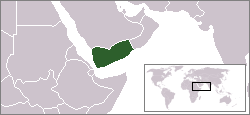|
Yemeni Cheese
Yemeni cheese also known as Taiz cheese and known in Yemen as "local cheese" (Jubn Baladi), is a type of Yemeni cheese that is produced in rural areas of Yemen most famously in Taiz Governorate which is why it is known as Taizz cheese although other local names are given based on the region or the village the cheese was produced. Visitors to Taiz city usually buy the Taiz cheese in al-Bab al-Kabeer and Bab Musa markets as gifts for their families. The production of the Taiz cheese has not been affected by the production of processed cheese because most Yemenis still prefer the local cheese. Characteristics The Taiz cheese is smoked. Different types of plants are used to smoke the cheese which gives it the brown color and a special flavor depending on the plants that are used for smoking. Method of production Yemeni cheese is usually prepared in the evening. The milk is collected during the day in pots to be coagulated. The coagulant used is the stomach of a suckling lamb, kid ... [...More Info...] [...Related Items...] OR: [Wikipedia] [Google] [Baidu] |
Yemen
Yemen (; ar, ٱلْيَمَن, al-Yaman), officially the Republic of Yemen,, ) is a country in Western Asia. It is situated on the southern end of the Arabian Peninsula, and borders Saudi Arabia to the Saudi Arabia–Yemen border, north and Oman to the Oman–Yemen border, northeast and shares maritime borders with Eritrea, Djibouti, and Somalia. Yemen is the second-largest Arabs, Arab sovereign state in the peninsula, occupying , with a coastline stretching about . Its constitutionally stated Capital city, capital, and largest city, is Sanaa. As of 2021, Yemen has an estimated population of some 30.4 million. In ancient times, Yemen was the home of the Sabaeans, a trading state that included parts of modern-day Ethiopia and Eritrea. Later in 275 AD, the Himyarite Kingdom was influenced by Judaism. Christianity arrived in the fourth century. Islam spread quickly in the seventh century and Yemenite troops were crucial in the early Islamic conquests. Several Dynasty, dynasties ... [...More Info...] [...Related Items...] OR: [Wikipedia] [Google] [Baidu] |
Taiz Governorate
Taiz ( ar, تَعِزّ, Taʿizz) is a governorate of Yemen. The governorate's capital is Taiz, which is the third largest city in Yemen. Today it is the most important commercial centre in Yemen owing to its proximity to the richest farmland in the nation and to the important Red Sea port of Mocha. It also has an international airport, Taiz International Airport, with numerous services within Yemen and to neighbouring countries. Geography For such a small area, Taiz Governorate has an extraordinarily diverse geography. The western half of the governorate is part of the Tihamah coastal plain and has an exceedingly hot, humid and arid climate. The eastern half, however, is very mountainous, with the major peak being 3,070-metre-high Jabal Sabir, near Taiz city. These mountains trap the moisture created by an upper-level wind reversal between April and October, so that in the eastern half of the governorate annual rainfall increases from 200 millimetres (8 inches) in the foothi ... [...More Info...] [...Related Items...] OR: [Wikipedia] [Google] [Baidu] |
Taiz
Taiz ( ar, تَعِزّ, Taʿizz) is a city in southwestern Yemen. It is located in the Yemeni Highlands, near the port city of Mocha, Yemen, Mocha on the Red Sea, at an elevation of about above sea level. It is the capital of Taiz Governorate. With a population of over 600,000 in 2005, it is the largest city in Yemen in terms of population ahead of the capital Sana'a and the southern port city of Aden. Due to the Taiz campaign (2015–present), ongoing campaign as part of Yemeni Civil War (2015–present), Yemen's civil war, Taiz is a battleground and a war zone. Once known as the "cultural capital of Yemen", the war has bestowed a new title, "city of snipers". History The 14th century traveller Ibn Battuta visited Taiz: We went on ... to the town of Taʻizz, the capital of the king of Yemen, and one of the finest and largest towns in that country. Its people are overbearing, insolent, and rude, as is generally the case in towns where kings reside. Taʻizz is made up of thre ... [...More Info...] [...Related Items...] OR: [Wikipedia] [Google] [Baidu] |
Yemeni Cuisine
Yemeni cuisine is distinct from the wider Middle Eastern cuisines, but with a degree of regional variation. Although some foreign influences are evident in some regions of the country (with Ottoman cuisine, Ottoman influences showing in Sanaa, while Indian cuisine, Indian influence is evident in the southern areas around Aden and Mukalla), the Yemeni kitchen is based on similar foundations across the country. Customs The generous offering of food to guests is one of the customs in Culture of Yemen, Yemeni culture, and a guest not accepting the offering is considered as an insult. Meals are typically consumed while sitting on the floor or ground. Unlike the tradition in most Arab countries, lunch is the main meal of the day in Yemen, not dinner. Food preparation In Yemen, many kitchens have a ''tandoor'' (also called ''tannur''), which is a round clay oven. Fruits and vegetables Tomatoes, onions, and potatoes are some of the staple fruits and vegetables in Yemen. Meat and dairy ... [...More Info...] [...Related Items...] OR: [Wikipedia] [Google] [Baidu] |

